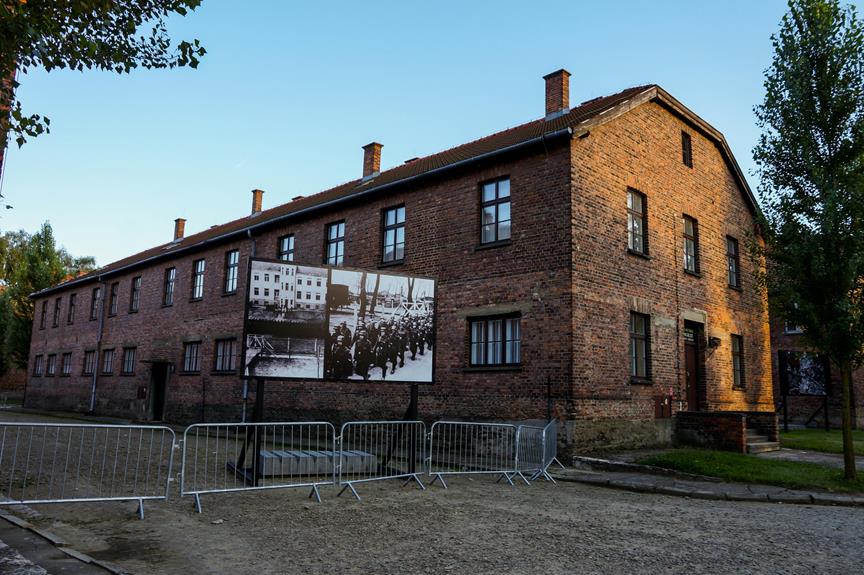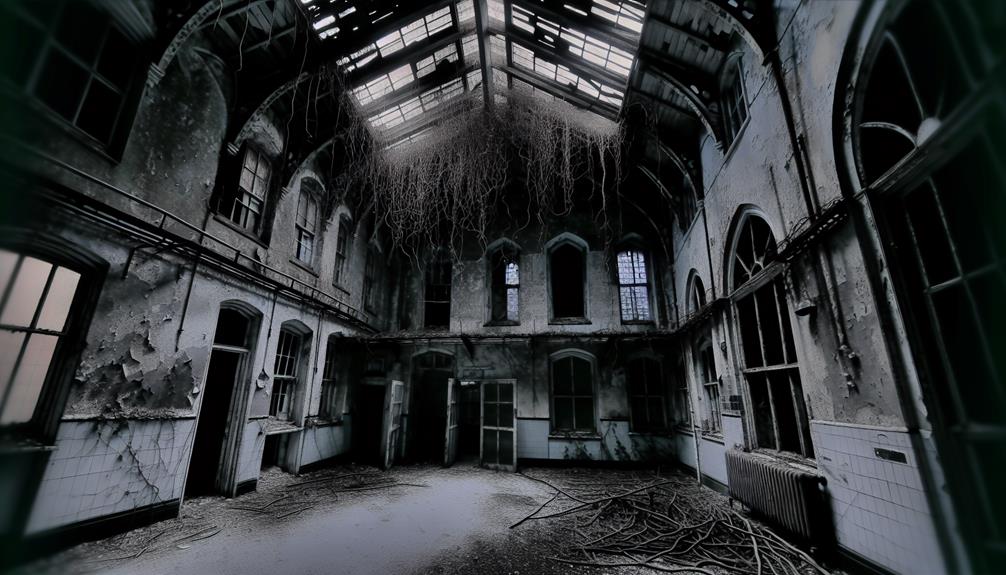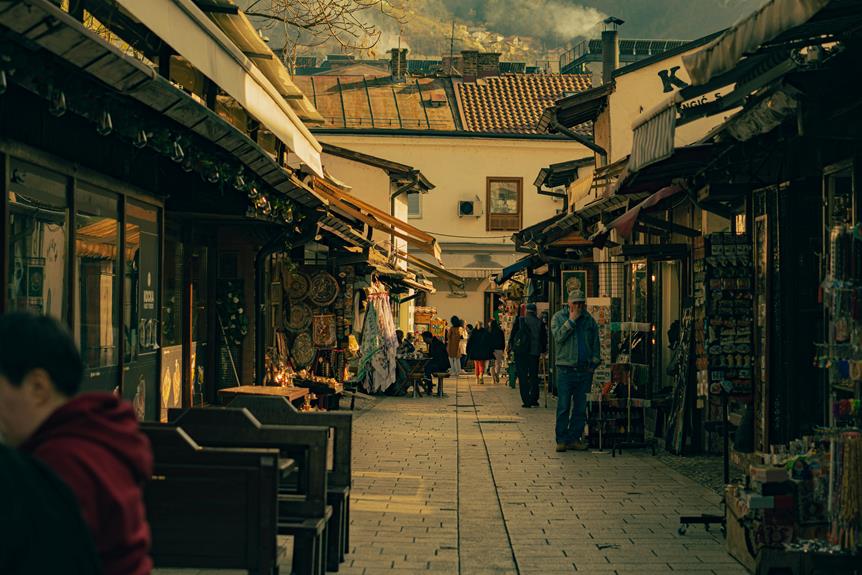Auschwitz-Birkenau, the infamous Nazi concentration camp, holds within its barbed wire fences a history that transcends time. The mere mention of its name evokes a sense of foreboding and reflection, as visitors walk through its haunting grounds. From the chilling selection process to the daily atrocities faced by prisoners, the echoes of suffering linger in the air. However, amidst the darkness, glimmers of resilience and remembrance emerge, shedding light on a past that demands acknowledgment and understanding.
Key Takeaways
- Auschwitz-Birkenau, the largest Nazi camp in Poland, symbolizes Holocaust horrors.
- Selection process categorized prisoners for labor or gas chambers based on Nazi ideology.
- Daily life included brutality, survival strategies, and prisoner solidarity.
- Medical experiments violated human rights, leaving lasting psychological scars.
- Resistance, revolts, and uprisings within the camp demonstrated courage and resilience.
The History of Auschwitz-Birkenau
The origins of Auschwitz-Birkenau can be traced back to its establishment by the Nazi regime in 1940 as a concentration camp in occupied Poland. Under the brutal reign of the Nazis during World War II, Auschwitz-Birkenau became a symbol of the horrors of the Holocaust, a place where unspeakable atrocities were committed against millions of innocent people. The camp's solemn affirmation was to systematically exterminate individuals deemed undesirable by the Nazi regime, primarily targeting Jewish populations but also including Roma, Poles, Soviet prisoners of war, and others who opposed the regime.
During the Nazi occupation, Auschwitz-Birkenau evolved into a complex of multiple camps, with Birkenau serving as the largest killing center. The camp's strategic location in Poland facilitated the mass deportation of individuals from across Europe to their deaths in gas chambers. The haunting remnants of this dark history stand as a stark reminder of the depths of human cruelty and the importance of never forgetting the atrocities committed at this site.
Today, Auschwitz-Birkenau stands as a memorial and museum, a validation to the resilience of Holocaust survivors and a somber tribute to those who perished within its walls. Visiting this site offers a solemn opportunity to pay respects to the victims, learn from the past, and honor the bravery of those who survived one of history's darkest chapters.
Arrival and Selection Process
Upon arrival at Auschwitz-Birkenau, individuals underwent a harrowing selection process that determined their fate within the confines of the camp. The arrival process was designed to dehumanize and categorize prisoners based on the Nazi ideology of racial purity and perceived usefulness. This selection process, often conducted by SS doctors, involved new arrivals being separated into two groups: those fit for labor and those deemed unfit, who were immediately sent to the gas chambers for extermination. The prisoner selection was a cruel and arbitrary procedure that inflicted further trauma on those already enduring the horrors of being transported to the camp.
To better understand the chilling reality of the arrival and selection process at Auschwitz-Birkenau, the following table provides a glimpse into the fate that awaited individuals as they stepped off the trains and into the clutches of the Nazi regime:
| Category | Fate |
|---|---|
| Fit for labor | Sent to barracks for slave labor |
| Deemed unfit | Immediately sent to gas chambers |
| Families with | Often separated, most sent to gas chambers |
| children | |
| Elderly or sick | Selected for immediate extermination |
| Pregnant women | Subjected to immediate execution |
This table illustrates the brutal efficiency of the arrival and selection process, highlighting the stark choices faced by those who arrived at Auschwitz-Birkenau.
Daily Life in the Camp
In the confines of Auschwitz-Birkenau, individuals faced a daily existence marked by relentless brutality and dehumanization. The daily life in the camp was a harrowing struggle for survival, where prisoners had to navigate a world designed to strip them of their humanity. Despite the dire circumstances, acts of prisoner solidarity emerged as beacons of hope amid the darkness.
- Survival strategies: Prisoners developed various strategies to increase their chances of survival, such as forming alliances with others, scavenging for extra scraps of food, or feigning strength and health during selections.
- Prisoner solidarity: In the face of unimaginable adversity, prisoners often came together to support one another. Whether through sharing meager rations, providing comfort in times of despair, or collectively resisting the dehumanizing treatment, solidarity among inmates was a source of strength and resilience.
- Acts of defiance: Amid the oppression, prisoners exhibited acts of defiance to retain their sense of self-worth and dignity. Whether it was engaging in clandestine education, secretly practicing religious rituals, or simply refusing to let go of their identity, these acts symbolized a resistance to the dehumanization they faced daily.
In this environment of extreme hardship, the bonds formed through survival strategies and prisoner solidarity served as a declaration of the enduring human spirit in the face of unspeakable atrocities.
The Horrors of Medical Experiments
Amidst the harrowing reality of Auschwitz-Birkenau, the unspeakable horrors of medical experiments inflicted upon prisoners stand as a powerful demonstration of the depths of human cruelty and suffering. These experiments, conducted under the guise of medical research, violated all notions of ethical implications, trampling on basic human rights and disregarding fundamental principles of medical ethics.
The psychological impact on those subjected to these experiments was profound and lasting. Victims were often deceived or coerced into procedures that caused immense physical and emotional pain. The dehumanization of individuals reduced them to mere objects for experimentation, stripping away their dignity and autonomy.
The legacy of these atrocities serves as a stark reminder of the consequences of unchecked power and the importance of upholding human rights. It underscores the critical need for vigilance in ensuring that such violations never occur again. Reflecting on the horrors of medical experiments at Auschwitz-Birkenau compels us to confront the darkest aspects of our shared history and reaffirm our commitment to safeguarding the dignity and well-being of all individuals.
In examining this chapter of the Holocaust, we are confronted with the chilling reality of how far human beings can deviate from morality and compassion. It serves as a call to action to uphold the values of justice, empathy, and respect for all, honoring the memory of those who suffered unimaginable horrors in the name of pseudo-science.
Resistance and Revolts
The defiance and acts of resistance displayed by prisoners within Auschwitz-Birkenau, particularly amidst the backdrop of unimaginable suffering, reveal a profound evidence to the resilience and courage of individuals in the face of extreme adversity. Despite the overwhelming odds stacked against them, prisoners found ways to resist the dehumanization and brutality they faced on a daily basis. This resistance took various forms, from small acts of sabotage to larger uprisings that showed the undying spirit of those imprisoned within the camp.
- Secret Communication: Prisoners risked their lives to maintain a semblance of communication with each other, passing along messages of hope, solidarity, and resistance. These small acts of defiance helped to maintain a sense of humanity in a place designed to strip it away.
- Sabotage: Through acts of sabotage, prisoners attempted to disrupt the machinery of the camp, slowing down the Nazi war effort and providing a form of resistance against their oppressors.
- Uprisings: Despite the overwhelming power of the Nazi regime, there were instances of organized uprisings within the camp. The most well-known of these was the uprising of October 1944, where prisoners in Auschwitz-Birkenau fought back against their captors, even if the outcome was ultimately tragic.
These acts of resistance, both big and small, serve as a demonstration to the strength and resilience of those who suffered within Auschwitz-Birkenau.
Liberation and Aftermath
Following the liberation of Auschwitz-Birkenau, the challenging aftermath of the Nazi concentration camp revealed the profound impact of the atrocities committed within its walls. The survivors faced not only physical scars but also deep emotional wounds that would take years, if not a lifetime, to heal. The process of rebuilding communities and fostering emotional healing was a monumental task that required immense support and understanding.
In the wake of liberation, the survivors of Auschwitz-Birkenau were faced with the formidable challenge of reclaiming their lives and identities. Many had lost family members, friends, and everything they once held dear. The process of emotional healing was complex and varied from individual to individual. Some found solace in sharing their stories and experiences, while others struggled to come to terms with the trauma they had endured.
Rebuilding communities in the aftermath of Auschwitz-Birkenau was essential for the survivors to regain a sense of belonging and support. The bonds forged through shared suffering became a source of strength and resilience. Despite the unimaginable horrors they had witnessed, the survivors came together to create a sense of solidarity and hope for the future.
The legacy of Auschwitz-Birkenau serves as a stark reminder of the atrocities that can occur when humanity loses its way. The process of rebuilding communities and fostering emotional healing continues to this day, as we work to ensure that such horrors are never repeated.
Remembering the Victims
In commemorating the victims of Auschwitz-Birkenau, it is essential to honor their memory with solemn reflection and reverence. The atrocities committed at this site must never be forgotten, and the victims should be remembered with the utmost respect. To achieve this, various methods are employed to honor and memorialize the victims:
- Educational Programs: Organizing educational programs helps to guarantee that the memory of the victims lives on. By learning about the history of Auschwitz-Birkenau, visitors gain a deeper understanding of the horrors that took place there and can pass on this knowledge to future generations.
- Remembrance Ceremonies: Holding remembrance ceremonies allows individuals to come together in solidarity to pay tribute to the victims. These ceremonies provide a space for collective mourning and reflection, fostering a sense of unity and shared responsibility in preserving the memory of those who perished.
- Creating Memorials: Erecting memorials within the camp grounds serves as a physical reminder of the lives lost during the Holocaust. These memorials stand as a testimony to the victims' suffering and ensure that their stories are not forgotten but are instead etched into the collective memory of humanity.
Frequently Asked Questions
How Were the Prisoners Transported to Auschwitz-Birkenau?
Transportation methods to Auschwitz-Birkenau were akin to a macabre symphony, with trains serving as the grim conductor.
Prisoners were packed into cattle cars, deprived of basic necessities during the arduous journey.
Arrival conditions were dehumanizing, as they faced separation from loved ones, immediate selection for labor or death, and the haunting realization of their grim fate.
The efficiency of the transport system masked the horrors that awaited, amplifying the prisoners' sense of despair.
Were Children Born in the Camp Allowed to Live?
In the context of life in the camp, the survival chances of children born in Auschwitz-Birkenau were exceedingly low.
The Nazi regime's policies aimed at extermination rather than preservation. Newborns and young children were typically subjected to immediate death, as they were considered unfit for labor and part of the targeted groups for mass murder.
The harsh conditions and systematic brutality within the camp left little room for the survival of infants and children.
Did Any Prisoners Manage to Escape From Auschwitz-Birkenau?
Survivor stories from Auschwitz-Birkenau recount numerous escape attempts, showcasing the resilience and courage of prisoners who sought freedom amidst unimaginable horrors.
While the heavily guarded camp made successful escapes rare, some individuals managed to evade capture temporarily.
These accounts shed light on the desperation and determination of those trapped within the confines of the Nazi concentration camp, offering a glimpse into the harrowing experiences faced by its inmates.
What Happened to the Belongings of the Prisoners?
The belongings of prisoners at Auschwitz-Birkenau were meticulously inventoried by the Nazis. These items, though stripped of their owners, hold immense cultural significance as symbols of the lives lost.
Today, memorials and museums work towards safeguarding these artifacts as a way to honor the memory of those who perished. Through the preservation of these belongings, we not only remember the victims but also guarantee that their stories are never forgotten.
How Did the Local Polish Population React to the Camp's Presence?
The local Polish population's reactions to the camp's presence varied. Some individuals were unaware of the extent of the atrocities committed at Auschwitz-Birkenau, while others harbored feelings of shame and horror.
The cultural impact of the camp's existence on the local community was significant, leading to introspection and a collective responsibility to remember and honor the victims. This complex interplay between historical awareness, emotions, and societal reflection continues to shape attitudes towards the site.
Conclusion
To sum up, Auschwitz-Birkenau serves as a stark reminder of the atrocities committed during the Holocaust. The history of the camp, the selection process, daily life, and the horrors of medical experiments illuminate the depths of human cruelty.
Despite the suffering endured by the prisoners, acts of resistance and remembrance efforts symbolize the importance of learning from the past. Let us never forget the victims of Auschwitz-Birkenau and endeavor to prevent such horrors from ever happening again.


